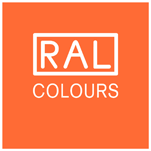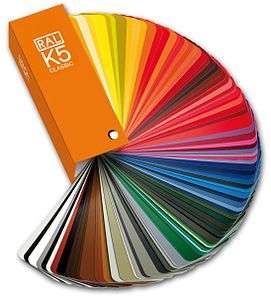RAL colour standard

RAL is a colour matching system used in Europe that is created and administrated by the German RAL gGmbH[1] (RAL non-profit LLC), which is a subsidiary of the German RAL Institute. In colloquial speech RAL refers to the RAL Classic system, mainly used for varnish and powder coating but nowadays there are reference panels for plastics as well. Approved RAL products are provided with a hologram as of early 2013 to make unauthorised versions difficult to produce. Imitations may show different hue and colour when observed under various light sources.
RAL colour space system

RAL Classic
In 1927 the German Reichs-Ausschuß für Lieferbedingungen und Gütesicherung (Imperial Commission for Delivery Terms and Quality Assurance) invented a collection of forty colours under the name of "RAL 840".[2] Prior to that date manufacturers and customers had to exchange samples to describe a tint, whereas from then on they would rely on numbers.[3]
In the 1930s the numbers were changed uniformly to four digits and the collection was renamed to "RAL 840 R" (R for revised). With tints constantly added to the collection, it was revised again in 1961 and changed to "RAL 840-HR", which consists of 210 colors and is in use to this day. In the 1960s the colours were given supplemental names to avoid confusion in case of transposed digits.
As "RAL 840-HR" covered only matte paint the 1980s saw the invention of "RAL 841-GL" for glossy surfaces, limited to 193 colours.[4] A main criterion for colours in the RAL Classic collection is to be of "paramount interest". Therefore, most of the colours in it are used on warning and traffic signs or are dedicated to government agencies and public services (for example: RAL 1004 - Swiss Postal Service, RAL 1021 - Austrian Postal Service, RAL 1032 - German Postal Service).[5] The first digit relates to the shade of the colour:
| Range | Range Name | First | Last | Quantity |
|---|---|---|---|---|
| RAL 1xxx | Yellow | RAL 1000 Green Beige | RAL 1037 Sun Yellow | 40 |
| RAL 2xxx | Orange | RAL 2000 Yellow Orange | RAL 2013 Pearl Orange | 14 |
| RAL 3xxx | Red | RAL 3000 Fire Red | RAL 3033 Pearl Pink | 34 |
| RAL 4xxx | Violet | RAL 4001 Red Purple | RAL 4012 Pearl Black Berry | 12 |
| RAL 5xxx | Blue | RAL 5000 Violet Blue | RAL 5026 Pearl Night Blue | 25 |
| RAL 6xxx | Green | RAL 6000 Patina Green | RAL 6038 Luminous Green | 36 |
| RAL 7xxx | Grey | RAL 7000 Squirrel Grey | RAL 7048 Pearl Mouse Grey | 38 |
| RAL 8xxx | Brown | RAL 8000 Green Brown | RAL 8029 Pearl Copper | 20 |
| RAL 9xxx | White/Black | RAL 9001 Cream | RAL 9023 Pearl Dark Grey | 14 |
RAL F9
This collection, which follows the naming of RAL Classic, was invented in 1984. It is nowadays made up of ten colours (RAL 1039-F9 Sand beige, RAL 1040-F9 Clay beige, RAL 6031-F9 Bronze green, RAL 6040-F9-Light olive, RAL 7050-F9 Camouflage grey, RAL 8027-F9 Leather brown, RAL 8027-F9 Leather brown, RAL 8031-F9 Sand brown, RAL 9021-F9 Tar black and RAL 6031-HR Bronze green for non-camouflage applications), used by the Bundeswehr for military camouflage coating.[6][7]
RAL Design
In 1993 a new colour matching system was introduced, tailored to the needs of architects, designers and advertisers. It started with 1,688 colours and was revised to 1,625 colours. The colours of RAL Classic and RAL Design do not intersect.
Contrary to the preceding systems, RAL Design features no names and its numbering follows a scheme based on the CIELAB colour space, specifically cylindrical CIEHLC. Each colour is represented by seven digits, grouped in a triple and two pairs, representing hue (000–360 degrees, angle in the CIELab color wheel), lightness (same as in L*a*b*) and chroma (relative saturation). The three numeric components of almost all RAL Design colours are multiples of 5, most are even divisible by 10.[8]
- Conversion from RAL Design number tuple to CIELAB
- "RAL 210 50 15" converts to L* = 50, a* = −12.99, b* = −7.5, for instance.
RAL Effect
RAL Effect comprises 420 solid colours and, as a particular highlight, seventy metallic colours. It is the first collection from RAL to be based on waterborne paint systems. No use is made of heavy metals such as lead, cadmium and chromates.
The newly developed, multifunctional double colour fan RAL E2 underlines the character of RAL Effect. RAL Effect allows eco-efficient colour production for all paint and lacquer producers.
RAL Digital
The software for architects, interior decorators and all those who deal with colours in a creative way. RAL Digital integrates the colours of RAL Classic, RAL Effect and RAL Design into graphics and CAD programs.
RAL Colour Feeling
"Colour Feeling 09/10" is primarily designed as a professional planning tool for designers, architects, interior designers, interior decorators and painters. It is meant to be a source of inspiration on how to creatively combine the main trend colours for the coming two years. But also general consumers can be inspired by the work book to develop their own ideas and to create their personal colour design.
See also
- List of RAL colors
- Colour chart, other colour systems and charts
- Federal Standard 595
- Natural Color System
- Pantone
References
- ↑ "Imprint". Retrieved 15 June 2016.
- ↑ "RAL Colours history". Retrieved 15 June 2016.
- ↑ "RAL Historie" (PDF). Retrieved 15 June 2016.
- ↑ "The RAL CLASSIC Colour Collection". Retrieved 15 June 2016.
- ↑ "How is the RAL CLASSIC colour collection structured?". Retrieved 15 June 2016.
- ↑ "RAL F9". Retrieved 15 June 2016.
- ↑ "Does RAL CLASSIC include the camouflage colours of Germany's Armed Forces?". Retrieved 15 June 2016.
- ↑ "Overview of all RAL Design colours".
External links
| Wikimedia Commons has media related to RAL-Color. |